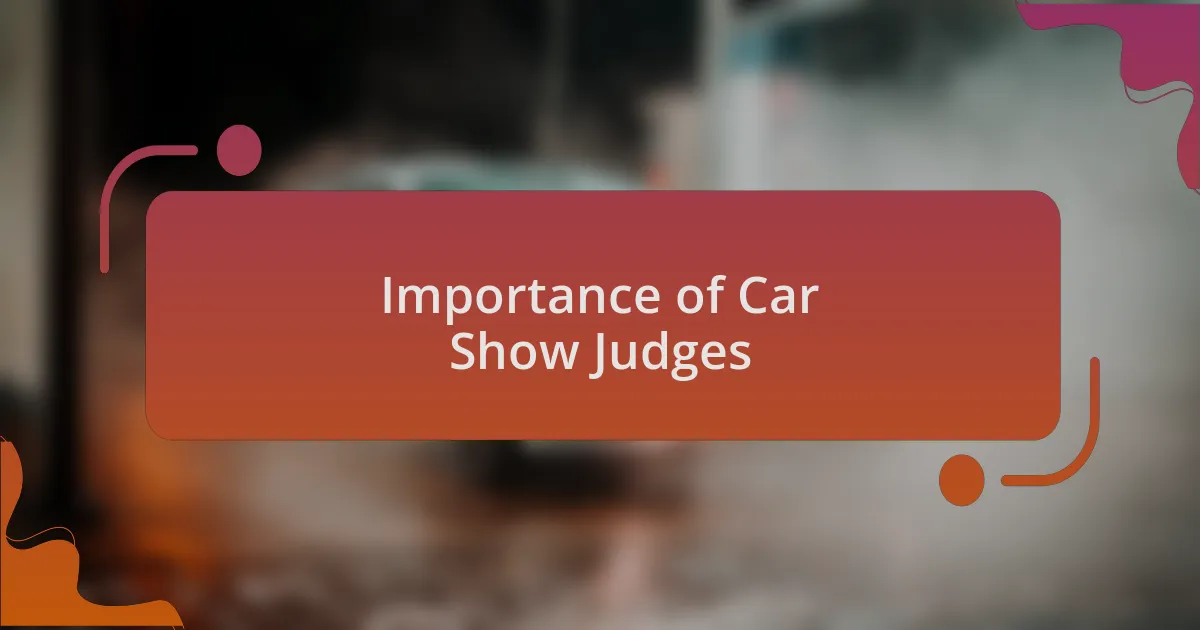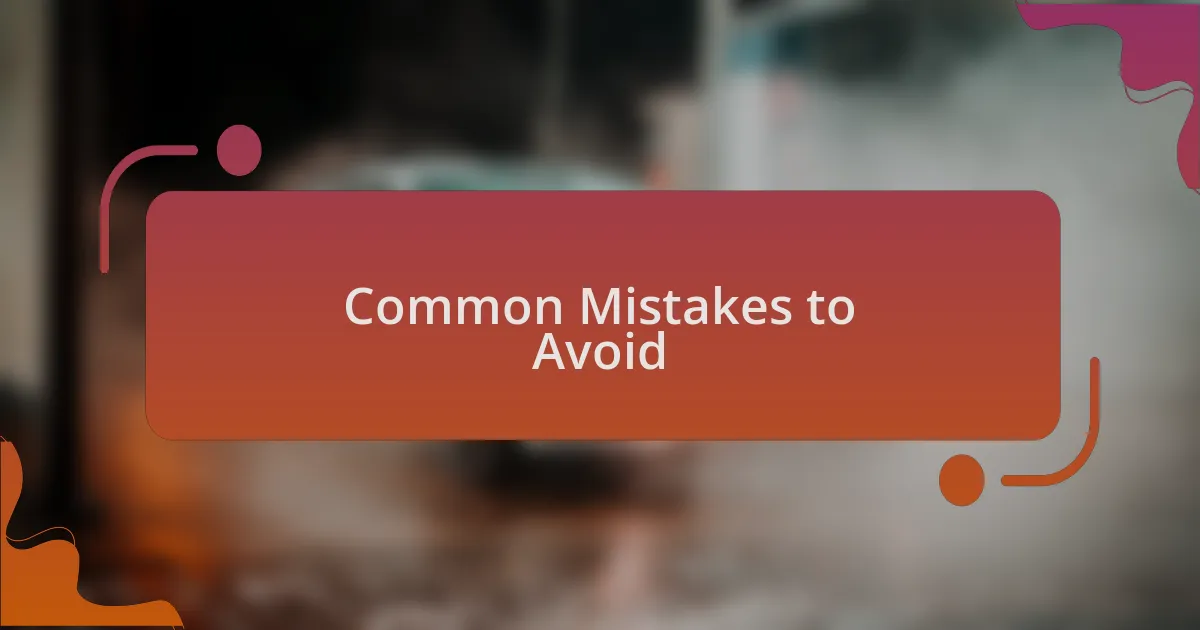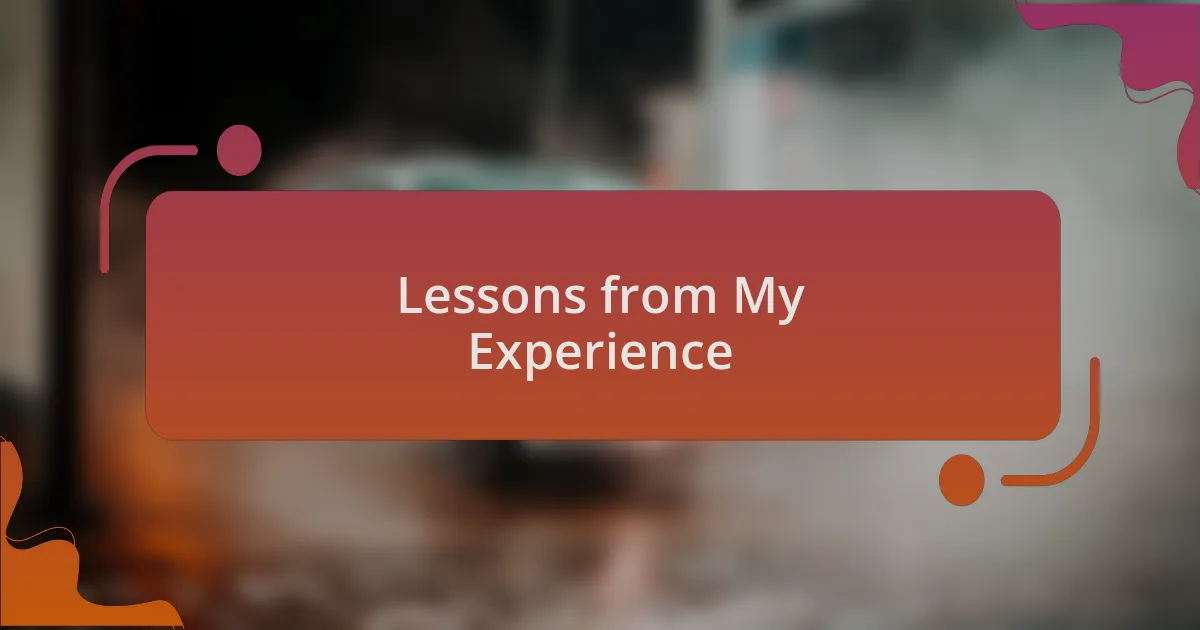Key takeaways:
- Vintage car expos are not just displays; they foster community and nostalgia among enthusiasts.
- Judges play a crucial role in enhancing the car show experience, providing valuable feedback and fostering connections.
- Common mistakes include neglecting details, the car’s backstory, and proper preparation before the event.
- Engaging with judges can lead to networking opportunities and a deeper appreciation for automotive history and craftsmanship.

Understanding Vintage Car Expos
Attending a vintage car expo is like stepping into a time capsule, where each vehicle tells its own unique story. I remember the first time I walked through an exhibition hall, completely entranced by the gleaming chrome and rich histories each car represented. Have you ever felt that thrill when standing beside a classic like a 1967 Mustang, imagining the adventures it must have seen on the open road?
These events are not just about showcasing cars; they are about celebrating a culture and community that spans generations. I often find myself striking up conversations with fellow enthusiasts, sharing the emotional ties we have to these classic cars. It’s fascinating how a single automobile can evoke nostalgia and spark discussions about family road trips or the first time behind the wheel.
At vintage car expos, the judging process adds another layer of excitement. I’ve noticed how judges not only evaluate the car’s aesthetics but also the passion and history behind it. This brings up an interesting question: what truly makes a car “vintage”? Is it the age, the craftsmanship, or the sentimental value it holds for its owner? Each perspective adds depth to the experience, transforming an ordinary expo into a heartfelt celebration of automotive artistry.

Importance of Car Show Judges
The role of car show judges is vital in elevating the overall experience of vintage car expos. I distinctly remember the anticipation that filled the air as I watched judges meticulously examine each vehicle, their expert eyes catching nuances that most attendees might miss. It made me realize that their evaluations bring not just validation to the owners but also a sense of integrity to the event, ensuring that every car is recognized for its unique story and craftsmanship.
Judges serve as a bridge between the cars and the passionate crowd. I once overheard a judge discussing the intricate details of a 1955 Chevy Bel Air, likening its design to a piece of art. That conversation sparked my curiosity and deepened my appreciation for the craftsmanship going into these vehicles. Have you ever considered how a judge’s commentary can transform your understanding of a car’s value beyond its monetary worth?
Ultimately, the presence of knowledgeable judges fosters a spirit of camaraderie among attendees and participants. Their insights not only help educate the viewer but also inspire owners to cherish and preserve their cars. I often find myself feeling a sense of pride when learning about the standards judges look for, as it encourages me to maintain my own vintage vehicle with the same level of passion and dedication. Isn’t it wonderful how a judge’s expertise can influence our understanding and love for these classic machines?

Common Mistakes to Avoid
When it comes to preparing for a car show, one common mistake I’ve noticed is overlooking the importance of details. During one expo, I remember a contender whose car had a stunning exterior but failed to shine under close inspection. The judges spent time examining the engine bay, and sadly, it didn’t match the pristine look of the outside. Have you ever considered how vital it is to provide a complete presentation that showcases every facet of your vehicle?
Another pitfall is neglecting the story behind the car. I recall chatting with a judge who emphasized how a compelling narrative can elevate a car’s appeal. A personal connection, perhaps about how the car was inherited or specific modifications made over the years, adds depth that resonates with both judges and attendees. Have you thought about how sharing your journey with the vehicle might captivate an audience?
Lastly, many owners seem to underestimate the power of preparation. I’ve seen participants arrive with their cars in less than pristine condition, thinking they could clean up at the venue. One experience taught me the importance of arriving not just ready but polished—the extra effort can turn heads and influence scores. How would you feel walking into a show knowing your car is at its absolute best?

Lessons from My Experience
While reflecting on my experiences with car show judges, I learned that feedback can often be a gift in disguise. During one show, a judge pointed out some overlooked imperfections on my car, which were painful to hear at first. However, that constructive criticism opened my eyes to areas of improvement I hadn’t considered before. How often do we let our pride block valuable insights?
I’ve also discovered that passion is contagious. At one expo, I watched how a judge’s enthusiasm for a particular make and model transfixed not only the owner but also the crowd. The way he spoke about the car’s history and its unique features brought the vehicle to life. Have you considered how sharing your enthusiasm can ignite a deeper connection with others around your car?
One of the most profound lessons I took away is the significance of community in this journey. I remember bonding with fellow competitors over our shared love for restoration, giving us all a sense of belonging. This camaraderie not only made the event more enjoyable but also helped me realize that we’re all in this together, learning from each other. Isn’t it amazing how the vintage car community can turn what might be a solitary hobby into a collaborative experience?

Applying Feedback from Judges
Applying feedback from judges is an essential part of personal and automotive growth. After receiving a detailed critique from a judge, I took a step back and viewed my car through a new lens. That initial sting of disappointment transformed into motivation as I immediately set out to correct those flaws. Have you ever felt that shift from frustration to determination? It feels incredibly empowering.
During one event, a judge suggested I focus more on the car’s original specifications rather than my personal modifications. I hadn’t considered the importance of historical accuracy until that moment. As I researched the original specs, I found a deeper appreciation for the vehicle’s legacy, and correcting my path felt like honoring its past. How often do we miss the stories behind what we restore?
I’ve learned to document feedback and track progress over time. After a show, I created a checklist based on judges’ remarks, which served not only as a guide for my restorations but also as a reminder of my growth. Each time I checked off a completed item, I felt a mix of pride and accountability. Isn’t it fascinating how a simple checklist can turn feedback into tangible progress? It’s like mapping out a journey where every mark is a milestone worth celebrating.

Benefits of Engaging with Judges
Engaging with judges at car shows offers invaluable insights that can significantly enhance your experience as both a car owner and enthusiast. I recall a time when I took the initiative to ask a judge about their evaluation process during a vintage car event. Their willingness to share tips on what they look for helped me understand the nuances of presentation and performance. Have you ever wondered how much a simple conversation can shape your approach?
Not only do judges provide constructive feedback, but they also open up networking opportunities with fellow enthusiasts and industry experts. At one show, I struck up a dialogue with a judge about specific restoration techniques. That conversation led to lasting friendships and mentorships, which I later found essential in navigating the vintage car community. How does building a network enrich your own journey in this vibrant world?
Moreover, engaging with judges can cultivate a sense of camaraderie and shared passion. When I participated in discussions with judges about their own restoration stories, it created a bond that extended beyond evaluations. Those moments reminded me that we all share similar challenges and triumphs in our journeys. Isn’t it reassuring to realize you’re part of a larger community that understands your love for vintage cars?